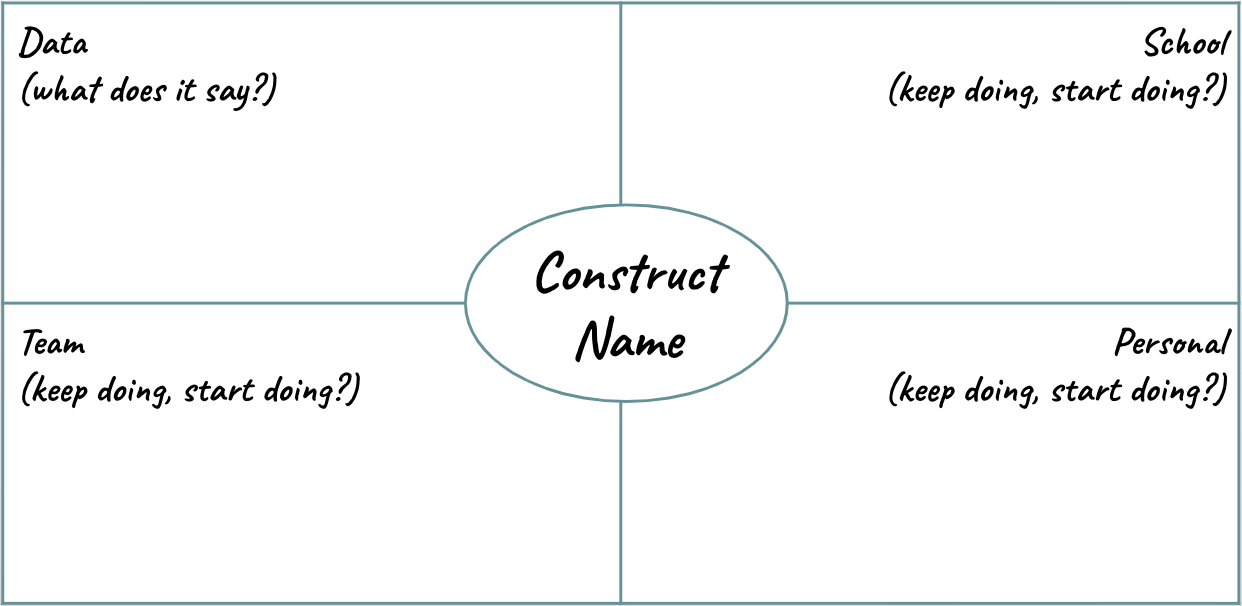Summary
When faculty or staff feel strongly connected to the vision and can clearly see how their role aligns with the strategic priorities, they feel valued and are motivated to do well. This professional learning session is part of a series that explores the eight aspects of organizational culture and climate measured by K20's research-based survey. Participants will look at the research factors relating to goals, supports, and structures and then reflect on the data collected from their school survey and identify strategies to help their school improve in this area.
Essential Question
How do goals, supports, and structures impact employee engagement within an organization?
Materials List
Session Slides (attached)
Magnetic Statements Posters (attached)
Research Brief (one per participant; attached)
Job Demand-Resources Model photo (attached)
Job Demand-Resources Model printout (one per participant; attached)
Job Demand-Resources Example/Non-Example handout (one per participant; attached)
Chart paper
Markers
Sticky notes
Learning Goals
Explore research-based characteristics of goals, supports, and structures.
Analyze survey constructs and data in the context of their organization.
Apply strategies to their role within their team and organization.
Engage
Start by displaying the essential question on slide 2 of the attached Session Slides. Remind participants that this session is intended to be a primer in the research constructs that informed the culture/climate survey they recently took. We will look at the data and explore strategies for better understanding and improving outcomes related to goals, supports, and structures.
Go to slide 3. Introduce participants to the Magnetic Statements strategy. Have participants stand up and walk around the room reading the Magnetic Statements Posters. Each participant should select the one that they are most drawn to. If you are worried about distribution, put a limit on how many can stand at each poster.
While standing in their group at their poster, have participants share out why they chose this quote and generally discuss the quote and what it says to them about the value of goals.
Move to slide 4. Have a representative from each group read their quote to the whole room and provide a 30-second summary of what their table talked about in relation to the quote. As each group shares, you may display the slide with their quote for the rest of the room to see (slides 5–8). After all groups have shared, participants can return to their seats.
Display the objectives on slide 9 and briefly go over the goals for this session.
Explore
Next, display slide 10 and begin handing out the attached Research Brief. Provide time for participants to read through and take notes as they read. Each participant should come up with a Point of Most Significance (POMS) that is their big take away from the research. Have them share their POMS with their table group.
Move to slide 11, which shows a diagram of the job demand-resources model. Explain the model briefly and how job satisfaction, climate/culture, and organizational outcomes are all related to the balance of demands and resources that each of an organization’s employees feel from day-to-day in their job. Managing this balance is key to improving the work environment.
Hand out the attached Job Demands-Resources Model Printout. Tell the participants that the Job Demands-Resources Model is a common framework for research on organizational climate/community. The basic concept is that job resources (emotional, organizational, social, etc.) increase motivation and commitment where job demands in these same areas lead to burnout, stress, and reduced well-being. The overall sense of job satisfaction and improved organizational outcomes in terms of performance and culture are about the balance between these two things. Demands exist and will influence the work climate, but resources can moderate and buffer any negative impacts they may have, so long as resources are adequate or even outweigh demands.
Explain
Move to slide 12 and begin handing out the attached Job Demands-Resources Examples/Non-Examples worksheet. Ask a volunteer to provide an example of a resource as a means to get ideas going and provide feedback. Preface the activity with a verbal notice that there are demands that can’t be changed sometimes related to policy, laws, etc. Remind participants that for this activity, we are wanting to look for the demands that we can have some impact on. Demands can be transformed into resources by asking for what you need, or can at least be lightened by resources.
Next, ask participants work as a table group to generate Examples and Non-Examples for each category provided:
Job design
Professional Development
Personal
After the group work is complete, ask each group to share out one resource from the list they generated at their table with the whole room.
Extend
Pull up slide 13 and ask participants to access both infographics and take a few moments to look at the data and understand what it objectively says. Point out that they might notice that a lot of these scales are about goals, even when they are not explicitly labeled “goals.” That is why we started where we did with the magnetic statements activity today: in order to set the frame.
Next, number the participants into groups. Consider how many groups you will need so there’s no more than five people per group.
As participants arrange into their numbered groups, provide each group with chart paper and a marker. Display slide 14 and direct participants to use this image as a guide to make a Frayer Model on their chart paper.
In the center, write the name of the data construct being analyzed
In the upper-left corner, write objective observations about the data (what does it say?)
In the upper-right corner, write ideas for what we as a School can do to improve this area (keep doing, start doing?)
In the lower-left corner, write ideas for what your Department/Team can do to improve this area (keep doing, start doing?)
In the lower-right corner, write ideas for what you can do Personally to improve this area (keep doing, start doing?)

Provide time for each group to look at the data and fill in the boxes for their Frayer Model.
Evaluate
Move on to slide 15 and hand out stacks of sticky notes to each group. Explain the Gallery Walk strategy. Have the groups walk clockwise around the room to spend a few minutes at each other group’s Frayer Model Poster.
As a group, they add a sticky note to each poster with a reaction or reflection, such as:
What idea you support most
Additional ideas
Questions you have
When all the groups have returned to their original poster, ask each group to share one thing from their poster that they feel was the most beneficial insight.
Research Rationale
Leadership makes a vital contribution to an organization’s culture and climate. Our leaders are the influencers and guides who form the organization's overall strategy, hiring practices, and working systems (Thummers et al., 2021). They facilitate the formation of our goals and guide our efforts toward these shared outcomes. The influence of leaders has both a direct and indirect effect on how the resources and demands of work impact employee engagement and work performance quality (Tummers et al., 2021; Albrecht et al., 2018; Ogbonnaya & Valizade, 2018). Four facets can help us understand how to better facilitate a positive climate around the direction of work are as follows: (1) goal clarity & strategic alignment; (2) clear feedback & communication; (3) supportive leadership practices; and (4) human resources.
Follow Up Activities
Examine some of the ideas written on the frayer model posters in a leadership meeting.
What connections do you draw between the responses for goals, supports, and structures?
What ideas, positions, or assumptions do you want to challenge or question?
What key concepts or ideas do you think are important and worth focusing on moving forward?
What changes in attitudes, thinking, or action are suggested by the staff feedback either for the whole school or teams?
Have each leader create a summary statement of the key points and themes. Have leaders identify 1-2 actionable items.
Share the themes and action items with staff. Have each person create their own summary statement of the themes and identify 1-2 actionable items for themselves.
Resources
Albrecht, S., Breidahl, E., & Marty, A. (2018). Organizational resources, organizational engagement climate, and employee engagement. The Career Development International, 23(1), 67–85.
Forbes Councils Expert Panel® (2023, January 12). Council post: How to effectively communicate company goals with your employees. Forbes. Retrieved February 20, 2023
K20 Center. (n.d.). 30 Second Expert. Strategies. https://learn.k20center.ou.edu/strategy/1048
K20 Center. (n.d.). Examples and Non-Examples. Strategies. https://learn.k20center.ou.edu/strategy/163
K20 Center. (n.d.). Frayer Model. Strategies. https://learn.k20center.ou.edu/strategy/126
K20 Center. (n.d.). Gallery Walk. Strategies. https://learn.k20center.ou.edu/strategy/118
K20 Center. (n.d.). Magnetic Statements. Strategies. https://learn.k20center.ou.edu/strategy/166
K20 Center. (n.d.). Point of Most Significance. Strategies. https://learn.k20center.ou.edu/strategy/101
Ogbonnaya, C., & Valizade, D. (2018). High performance work practices, employee outcomes and organizational performance: A 2-1-2 multilevel mediation analysis. The International Journal of Human Resource Management, 29(2), 239–259.
Rouleau, K. (2021). Balanced leadership for student learning: A 2021 update of McREL's research-based school leadership development program. McREL International.
Tummers, L. G., & Bakker, A. B. (2021). Leadership and job demands-resources theory: A systematic review. Frontiers in Psychology, 12. https://doi.org/10.3389/fpsyg.2021.722080
Walden, J., Jung, E. H., & Westerman, C. Y. K. (2017). Employee communication, job engagement, and organizational commitment: A study of members of the Millennial Generation. Journal of Public Relations Research, 29(2-3), 73–89.



